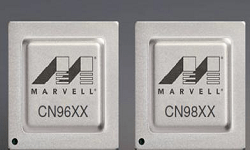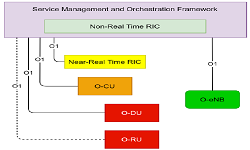What is eCPRI, how it contributes to 5G and Open RAN?
The Common Public Radio Interface (CPRI) is an industry cooperation aimed at defining publicly available specifications for the key internal interface of remote radio head (RRH) or Radio Equipment (RE), and base station unit (BBU) or Radio Equipment Controller (REC) via a so-called fronthaul transport network.
RRH are distributed on the towers every few miles in cities and suburban areas. These RRHs has to be connected to baseband units sitting at centralized locations. The connection between the RRUs and the base station is often referred to as “fronthaul.”
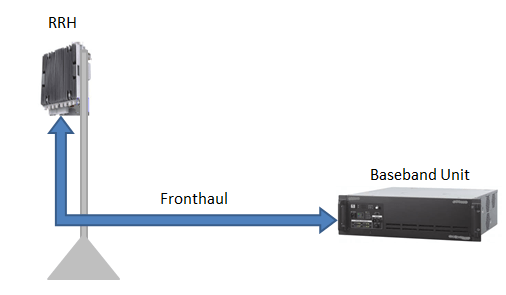
In 4G (LTE), we use Common Public Radio Interface (CPRI) interface as fronthaul connection, but now, enhanced CPRI (i.e. eCPRI) is becoming an important technology for 5G and Open RAN.
The scope of the eCPRI specification is to enable efficient and flexible radio data transmission via a packet based fronthaul transport network like IP or Ethernet. eCPRI defines a protocol layer which provides various – mainly User Plane data specific – services to the upper layers of the protocol stack.
eCPRI Protocol Planes:
Method to access one or more functionalities via the eCPRI protocol. This method typically involves the transmission/reception of eCPRI messages.
The following planes are outlined:
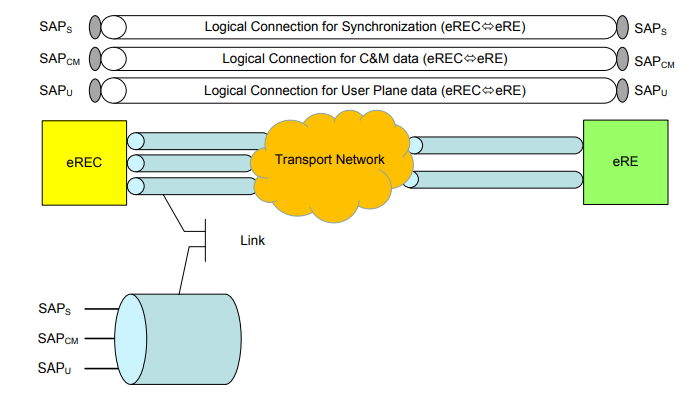
C&M Plane: Control and Management data flow for the operation, administration and maintenance of the nodes.
User Plane: Three data flows covered by the User Plane:
- Data flow to be transferred from the radio base station to the User Equipment (UE) and vice versa.
- Real time control data related to a).
- Other eCPRI flows not covered by other protocol planes/flows.
Synchronization Plane: Data flow for synchronization and timing information between nodes.
Functional Decomposition
The eCPRI specification supports 5G and enables increased efficiency in order to meet the needs foreseen for 5G Mobile Networks. In contrast to CPRI, the eCPRI specification supports more flexibility in the positioning of the functional split inside the Physical Layer of the cellular base station where the eREC (or BBU) contains part of the PHY layer functions and higher layer functions of the air interface, whereas the eRE (or RRH) contains the other part of the PHY layer functions and the analog radio frequency functions.
Below figure shows the protocol stack layers for a 3GPP 4G (LTE) or 5G (NR) radio base station. Five inter-layer functional splits numbered A to E are depicted in the figure.
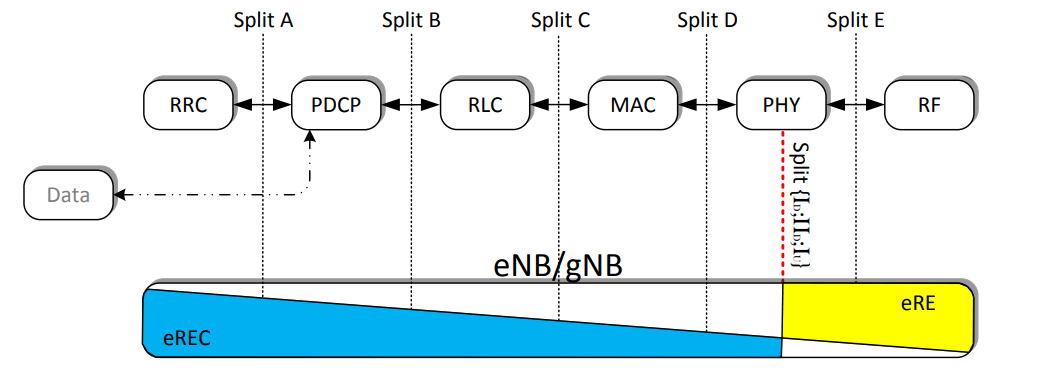
As shown in Figure, the eNB/gNB consists of only two units: the eREC and the eRE. For some of the splits an implementation with only two nodes may not be realistic. For instance, Split A with a central RRC and a distributed unit containing the rest of the protocol stack would not support a number of features (such as those requiring cell-coordination) efficiently. eCPRI assumes that the eNB/gNB consists of eREC and eRE(s) only and thus the following text should be read with this in mind. The intra PHY Split is marked with a red line, this is just an example showing how the figure shall be interpreted, the blue and yellow colored areas in a eNB/gNB show what parts are located in eREC and eRE.
The advantages of the intra-PHY-split are: features such as Carrier Aggregation, Network MIMO, Downlink CoMP, Uplink L1 Comp Joint Processing can be efficiently supported. Some of these features might of course be supported by other splits as well. Some disadvantages of the intra-PHY-split are: A fronthaul network with “higher” capacity and “lower” latency is required compared to higher layer splits.
Table below shows how different splits will set different relative capacity- and latency-requirements on the fronthaul network.

One of the major objectives of a new functional split between eREC and eRE compared to the classical CPRI functional split is to lower the bit rates on the fronthaul interface. When looking at the different processing stages performed in the PHY-layer in downlink direction, three processes will mostly increase the bit rate. These three processes are modulation, the port-expansion being done in combination with the beamforming process and the IFFT+cyclic-prefix-process (i.e. going from the frequency domain to the time domain). By moving the split upwards in the figure the fronthaul bit rate will be lowered and vice versa. But conversely the bit rate for the user plane real-time control data will increase when moving the split point towards the MAC layer and vice versa.
Difference between eCPRI and CPRI
CPRI has the following characteristics:

- CPRI is a point-to-point interface by nature.
- There is a master-port and a slave-port connected directly by optical/electrical cable(s) (a hop).
- Networking functions are application layer functions and not supported by the CPRI interface itself.
- Supported topologies depend on REC/RE functions
- Supported logical connections include:
- Point-to-point (one REC – one RE).
- Point-to-multi-point (one REC – several REs).
- Redundancy, QoS, security, etc. are REC/RE functions (if required)
eCPRI has the following characteristics:
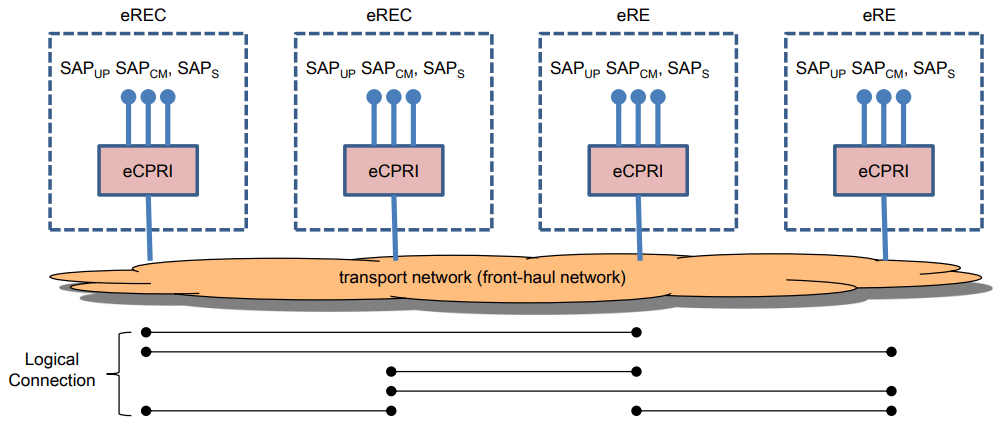
- There is no longer a master port/slave port classification at physical level
- The eCPRI layer is above the transport networking layer.
- The eCPRI layer does not care about the actual transport network layer topology
- The transport network may include some local network, e.g. local switch(es) provided by the eREC/eRE vendors.
- Supported logical connections include:
- Point-to-point (one eREC – one eRE), same as CPRI.
- Point-to-multi-point (one eREC – several eREs), same as CPRI
- Multi-point-to-multi-point (eRECs – eREs, eRECs – eRECs, eREs – eREs), new for eCPRI but not always necessary.
- Redundancy, QoS, security, etc. are mainly transport network functions; eCPRI nodes need to implement proper transport network layer protocols to support these capabilities if required.
Advantages of eCPRI
- 10x reduction of required bandwidth
- Required bandwidth can scale according to the to the user plane traffic
- Ethernet can carry eCPRI traffic and other traffic simultaneously, in the same switched network
- A single Ethernet network can simultaneously carry eCPRI traffic from several system vendors.
- Ethernet-OAM may be used for operation, administration, maintenance, provisioning, and troubleshooting of the network
- The new interface is a real-time traffic interface enabling use of sophisticated coordination algorithms guaranteeing best possible radio performance
- The interface is future proof allowing new feature introductions by SW updates in the radio network
- Jitter and latency will be reduced for high priority traffic using Time Sensitive Networking standard IEEE 802.1CM. The 802.1CM supports preemption of a low priority packet to schedule a high priority delay and jitter sensitive transmission.
eCPRI for 5G and Open RAN:
In 4G (LTE), fronthaul networks rely on semi-proprietary protocols such as CPRI and OBSAI. These protocols do not scale cost effectively for 5G because of its use of much larger spectral bands (hundreds of MHz) and massive MIMO. On the other hand, eCPRI protocol that scales bandwidth about 10x more effectively than 4G CPRI and thus requires fewer transport resources and eCPRI being an open interface also addresses the proprietary concerns making it easier for carriers to mix and match vendor equipment for their RRUs and their baseband units. And eCPRI is a packetized interface that can be framed within Ethernet to take advantage of the ubiquitous Ethernet networks already in existence.
References:
- eCPRI Specification

